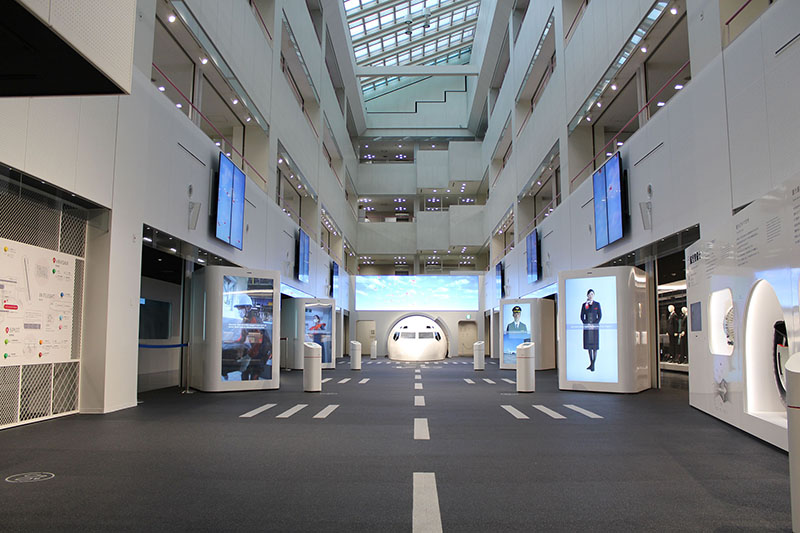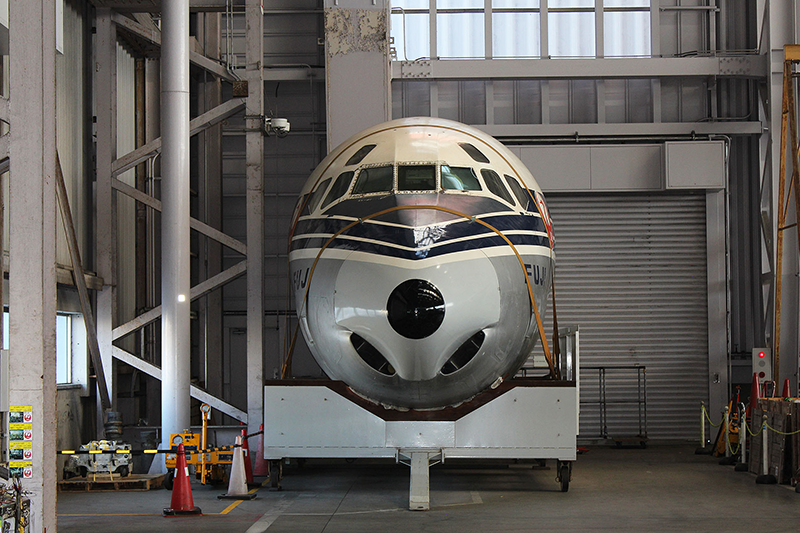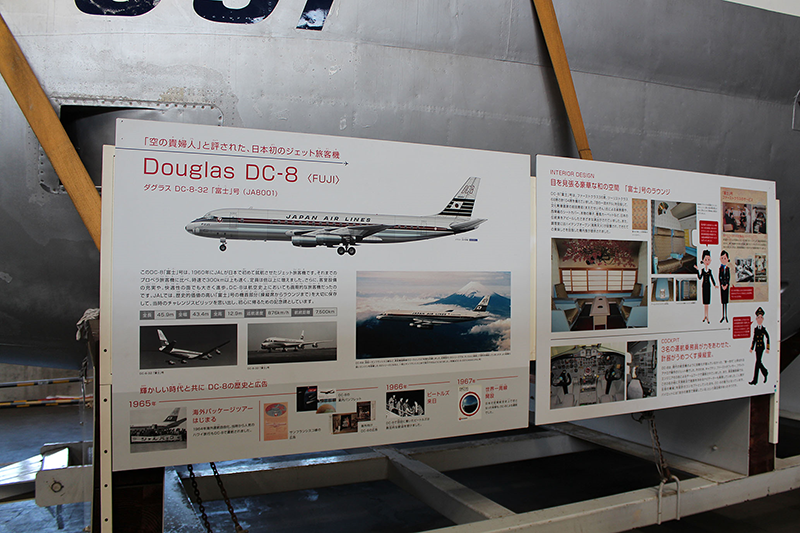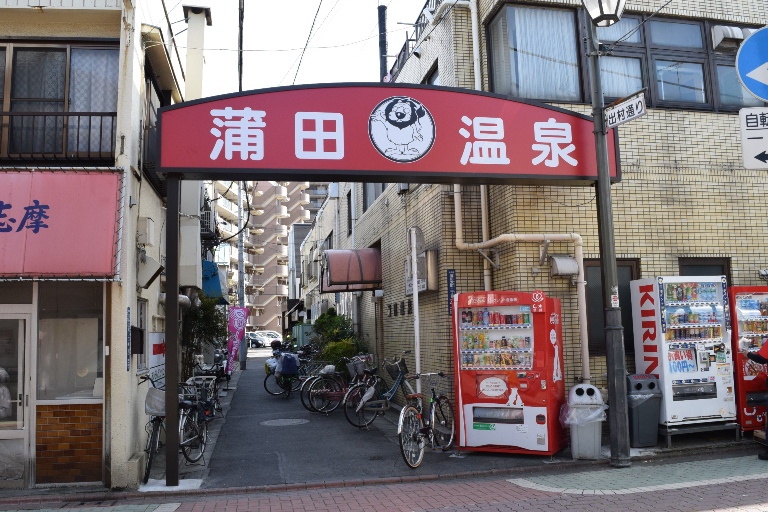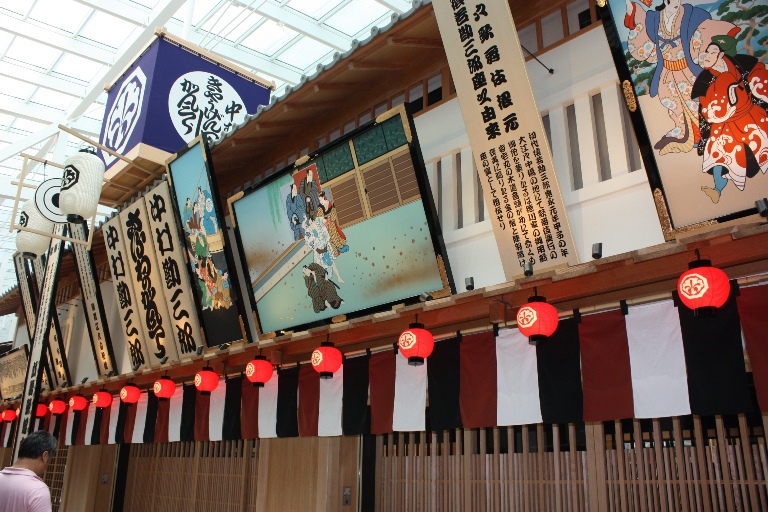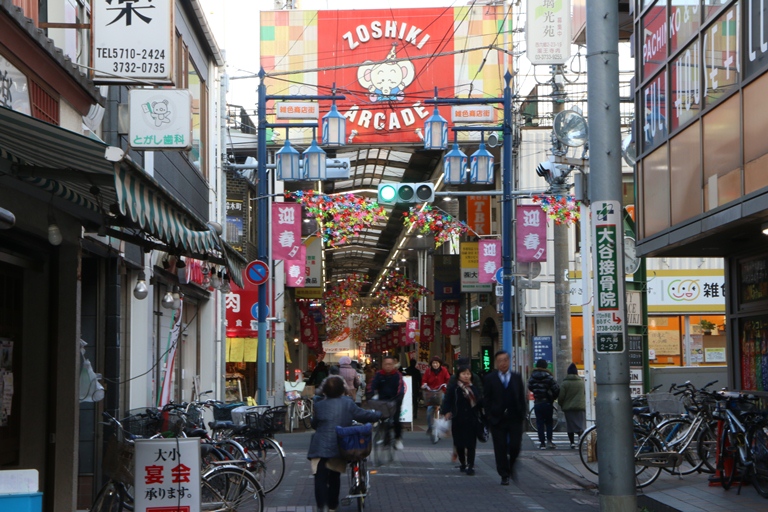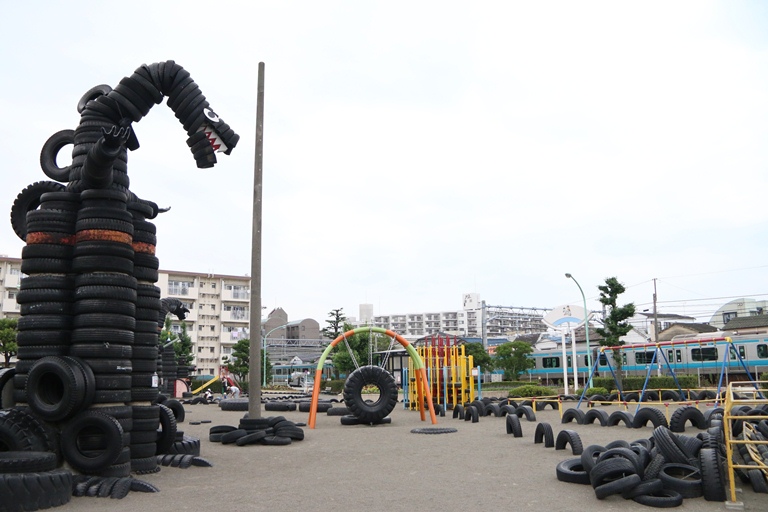Now, let’s check out the JAL SKY MUSEUM!
 After getting off at Shin Seibijo Station on Tokyo Monorail, a huge JAL sign appeared before us.
After getting off at Shin Seibijo Station on Tokyo Monorail, a huge JAL sign appeared before us.
Shin Seibijo Station on Tokyo Monorail is the closest station to JAL SKY MUSEUM, which is inside JAL Maintenance Center 1 (JAL M1 Building). Until we reached the station, we were able to overlook the airport and related facilities from the huge windows on the monorail, building up our excitement for the factory viewing tour. As there are no parking lots for cars or bicycles, please use either Tokyo Monorail or a taxi to visit.
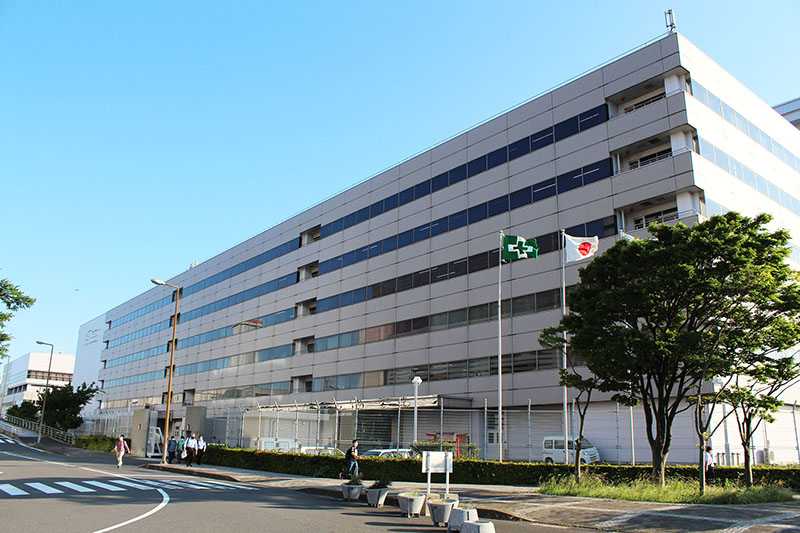 It takes about two minutes on foot from the station to JAL Maintenance Center 1 (JAL M1 Building).
It takes about two minutes on foot from the station to JAL Maintenance Center 1 (JAL M1 Building).
The reception starts about five minutes prior to the reserved time. Please note that you will not be able to go inside until the scheduled time even if you get there early. You can take pictures during the tour, but there are some materials you are not allowed to put on social media, so please listen to the explanation given before the tour.
(Currently, due to the countermeasures related to COVID-19, you will be asked to use hand sanitizer, keep social distance, and wear a mask.)
Now, let’s begin the tour!
Check in after receiving a pass
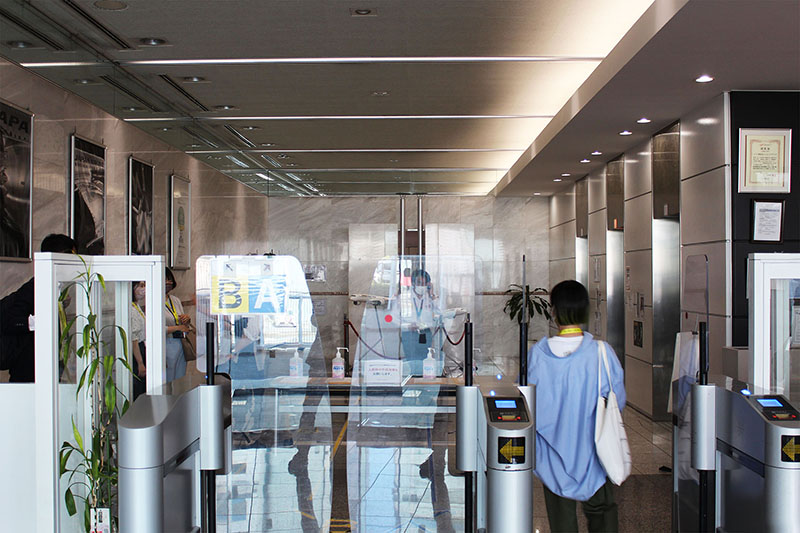
You will receive a pass called JAL GUEST CARD, so please go ahead and scan the QR code on the pass at the gate to enter. You will be using this pass within the museum, so make sure to keep it handy . You can take it home with you when the tour is finished. Since it has the date of the tour, it will be a good memento.
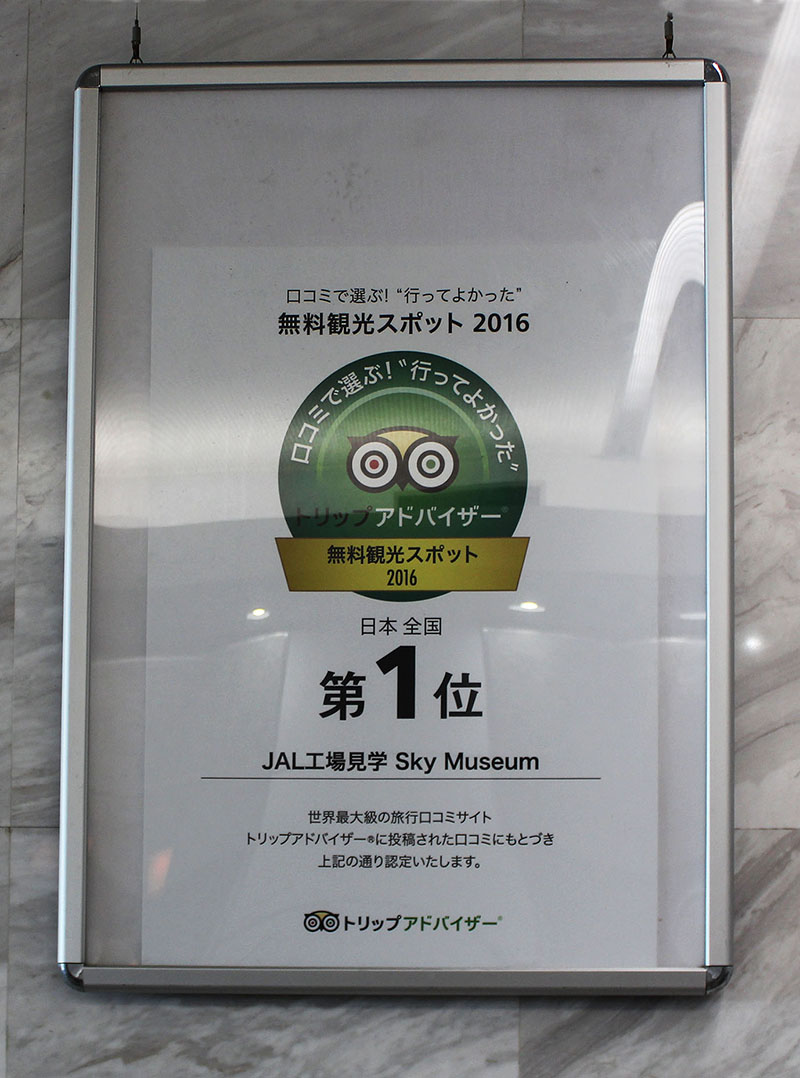
After going through the gate, you will see a display frame . There is a certificate from Tripadvisor, a review website related to travel, decorated on the wall for the facility receiving 1st place for free sightseeing spots. Amazing!
Museum experience 1: Sky Runway
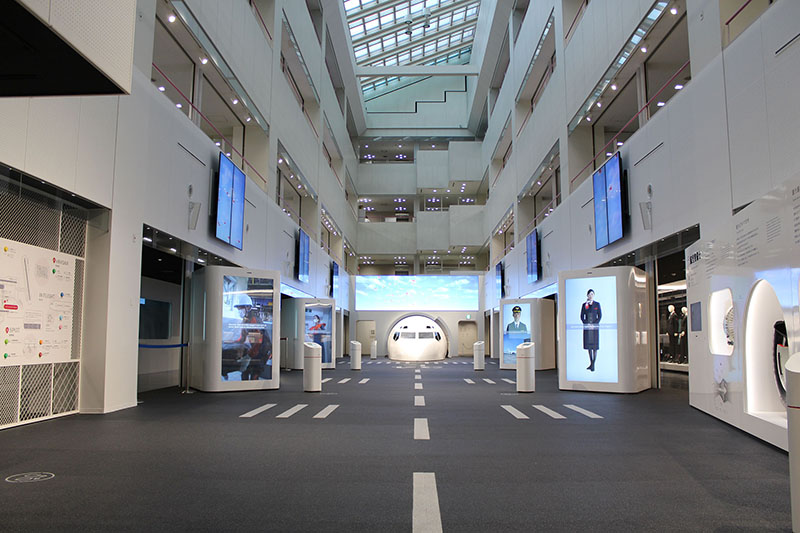 The theme of the exhibit area is a runway. We heard that this runway has been made parallel to the actual runways.
The theme of the exhibit area is a runway. We heard that this runway has been made parallel to the actual runways.
We will start the tour with the museum. We freely checked out the introduction of jobs that support flights and historic exhibits. We could not believe how fast time flew! Let us remind you that if you check these out thoroughly one by one, you will definitely run out of time.
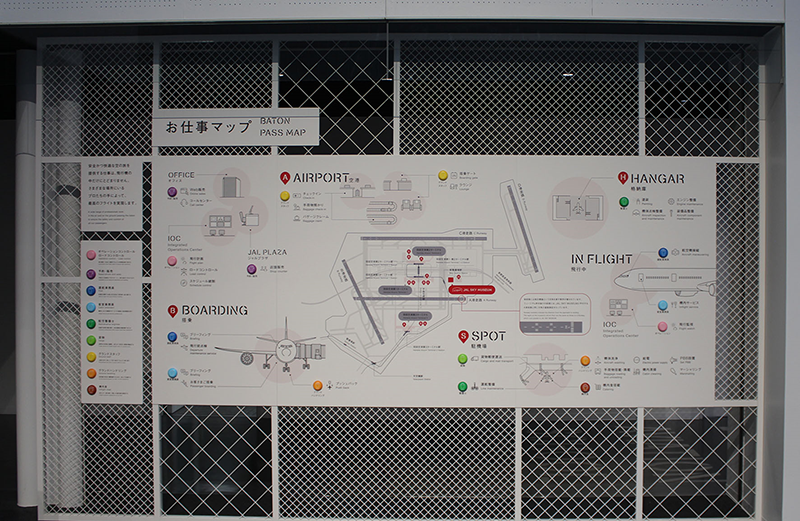 The map introduces which staff members are working what kind of jobs. It is easy to understand!
The map introduces which staff members are working what kind of jobs. It is easy to understand!
Multiple huge displays introduce the jobs of JAL staff members such as pilots, cabin attendants, ground handling staff, ground service staff, and maintenance engineers.
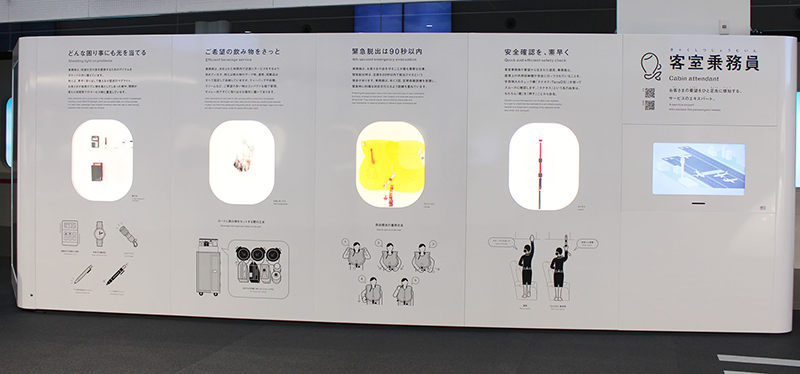
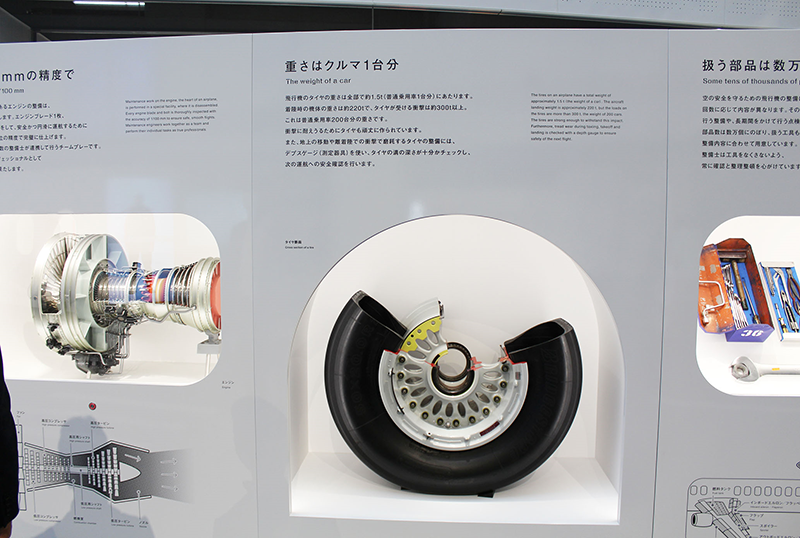 Along with the introduction of jobs, actual tools used by staff and related trivia are displayed as well.
Along with the introduction of jobs, actual tools used by staff and related trivia are displayed as well.
In the exhibit area, there are seven QR code readers. This is where you use the pass you received during the check-in. Scan the QR code on the pass, and you will be able to receive a Sky Trivia, which is related to the jobs.
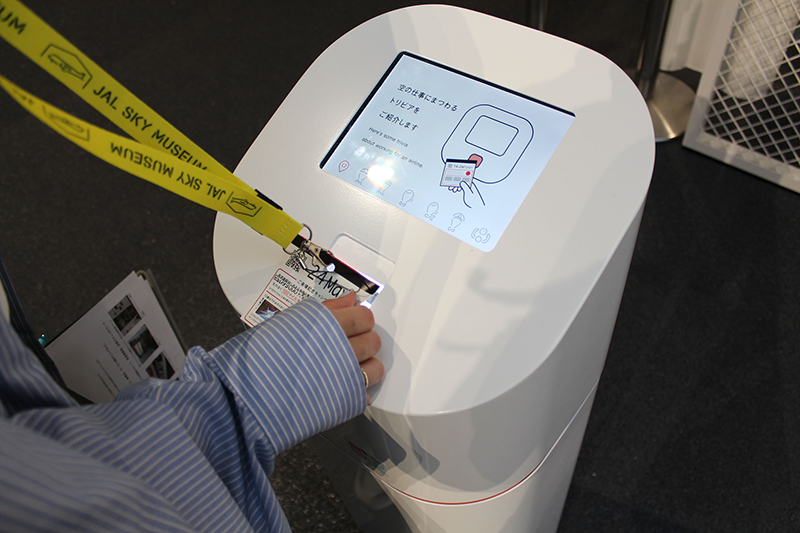 Each trivia is an interesting piece of information. Make sure to check them out.
Each trivia is an interesting piece of information. Make sure to check them out.
The mock-up (a full-scale model) of a cockpit, which has a huge presence in the exhibit area, used to be utilized as a flight simulator for JTA737. Even though the control stick is secured, you can still sit in the pilot’s seat and touch all kinds of switches.
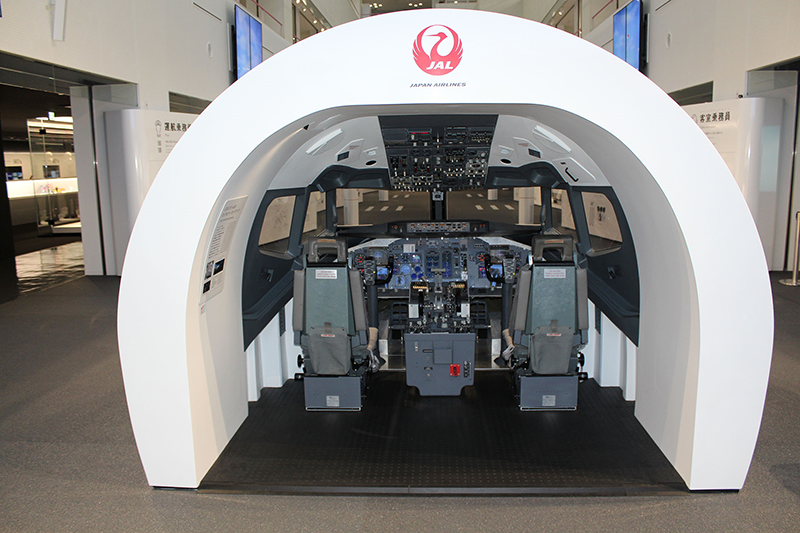 There are so many switches!
There are so many switches!
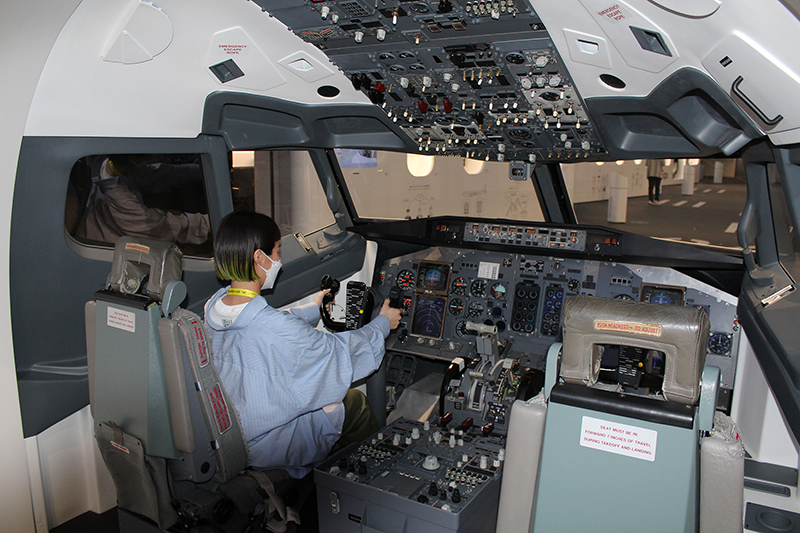 Our impression of it was that the pilot’s seat is a lot smaller than we thought it would be.
Our impression of it was that the pilot’s seat is a lot smaller than we thought it would be.
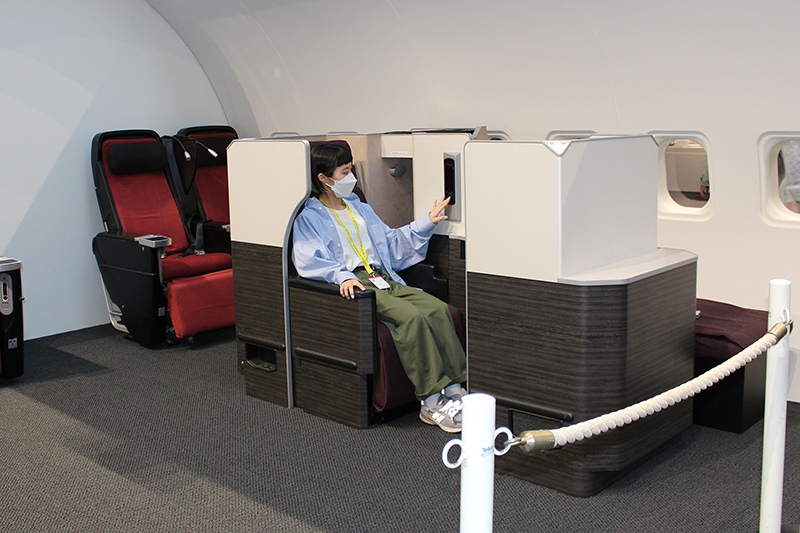 You can also try out a JAL Sky Suite seat and JAL Sky Premium seat. These are so comfortable!
You can also try out a JAL Sky Suite seat and JAL Sky Premium seat. These are so comfortable!
Museum experience 2: Archives Zone
The Archives Zone tells the history of JAL, exhibiting all the uniforms that JAL has ever had as well as model planes and goods. Under the concept to “convey the cultural history of aviation, not just aviation history,” the zone also touches on Japanese aviation history.
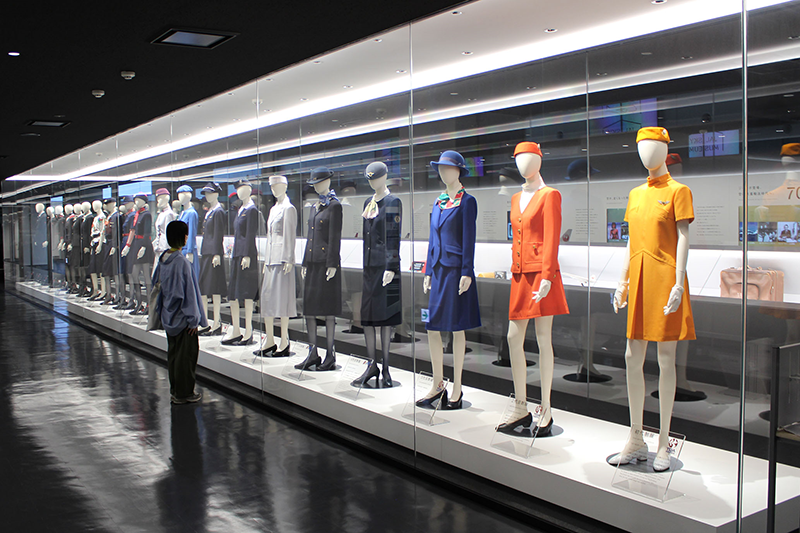 The past and present uniforms are exhibited in the middle of a corridor, allowing you to see them from the back side as well.
The past and present uniforms are exhibited in the middle of a corridor, allowing you to see them from the back side as well.
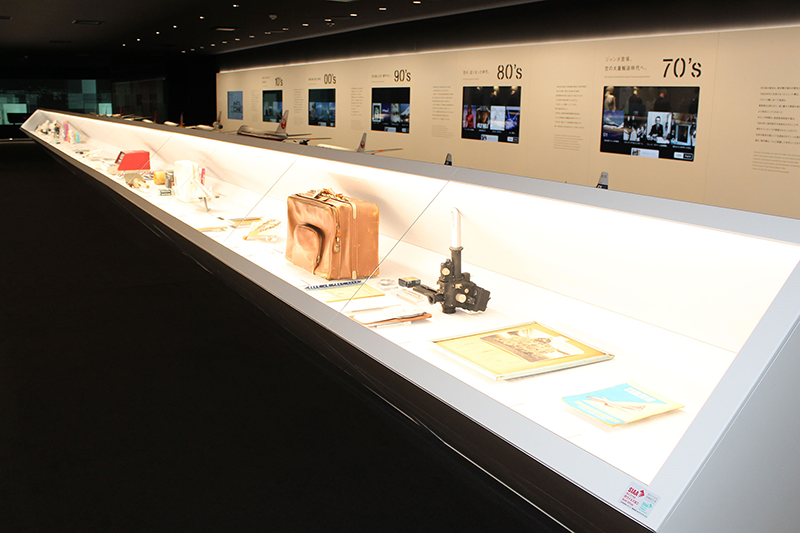 In the artifact section, we heard that a lot of participants of the tour talk about their memories of each era.
In the artifact section, we heard that a lot of participants of the tour talk about their memories of each era.
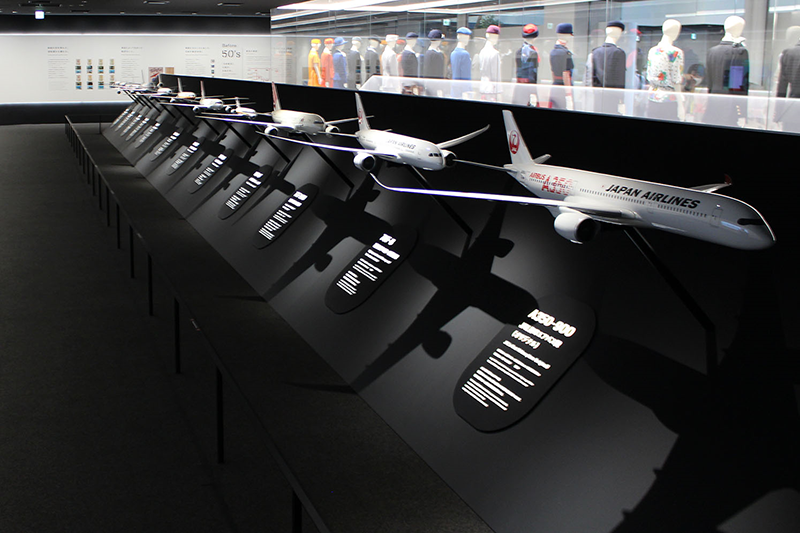 It is exciting to see this section with the past and present model display.
It is exciting to see this section with the past and present model display.
Museum experience 3: There are more of these great exhibits
The Future Zone surrounds you with digital displays and introduces JAL’s initiatives for the future. Operate the touch panel, and you will see images projected in three directions with themes: technology, food, and space. It is positively overwhelming.
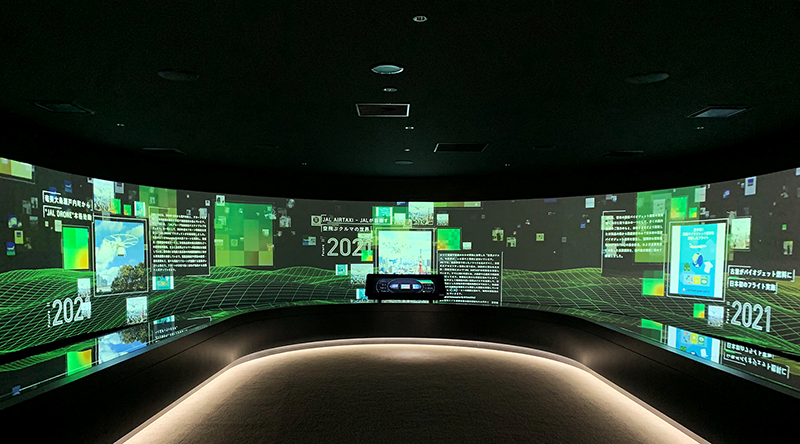 The theme of the Future Zone is JAL’s initiatives for the future. You will feel like you got lost in another dimension.
The theme of the Future Zone is JAL’s initiatives for the future. You will feel like you got lost in another dimension.
There is also a section that exhibits items related to special flights and flights for the imperial family as well as exhibits introducing the flight transporting the Olympic flame for the Tokyo 2020 Olympics. The best feature of this renovation is the increase in information and production to show the information all through digitalization. The exhibit area has some space reserved for wheelchairs so that those who are using wheelchairs can see the display with ease, which is pretty amazing.
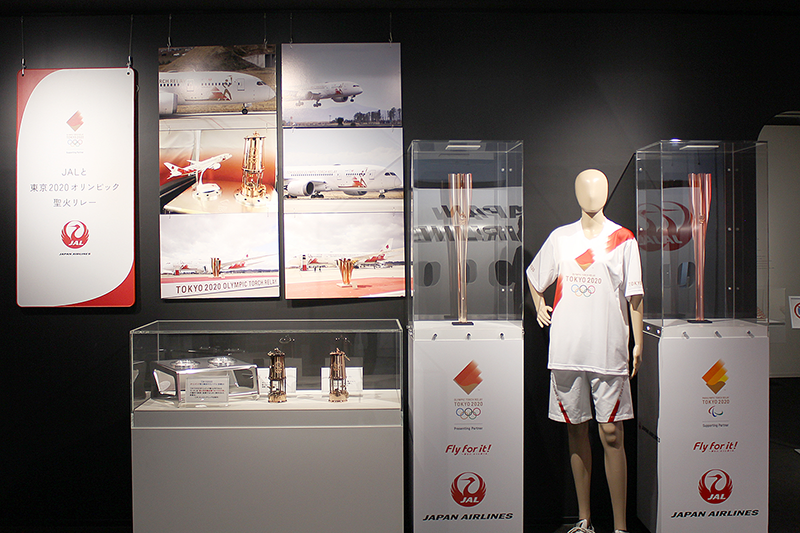 The Olympic flame for the Tokyo 2020 Olympics was transported by a plane operated collaboratively by JAL and ANA.
The Olympic flame for the Tokyo 2020 Olympics was transported by a plane operated collaboratively by JAL and ANA.
You definitely should not miss the museum shop. There are many JAL SKY MUSEUM original goods you can only purchase here. Other goods can also be purchased for 10-20% less than in the shops at airports. After you go for the hangar viewing, you will not be able to return to this area, so be sure to purchase anything you want at this time.
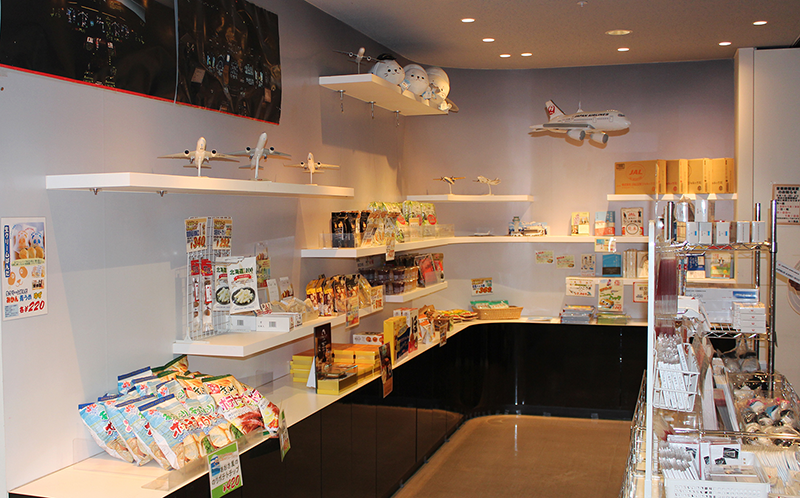
Finally getting to see planes at the anticipated hangar viewing!
With the guidance of a staff member, we went through a tour around the hangar for about 50 minutes. It is not common to be able to see airplanes up so close, so it was a succession of surprises. The staff member told us some interesting stories, and it was a lot of fun!
When the hangar door opened, we saw the scenery in the hangar right in front of our eyes. At a moment like this, anyone would let out a voice of excitement!
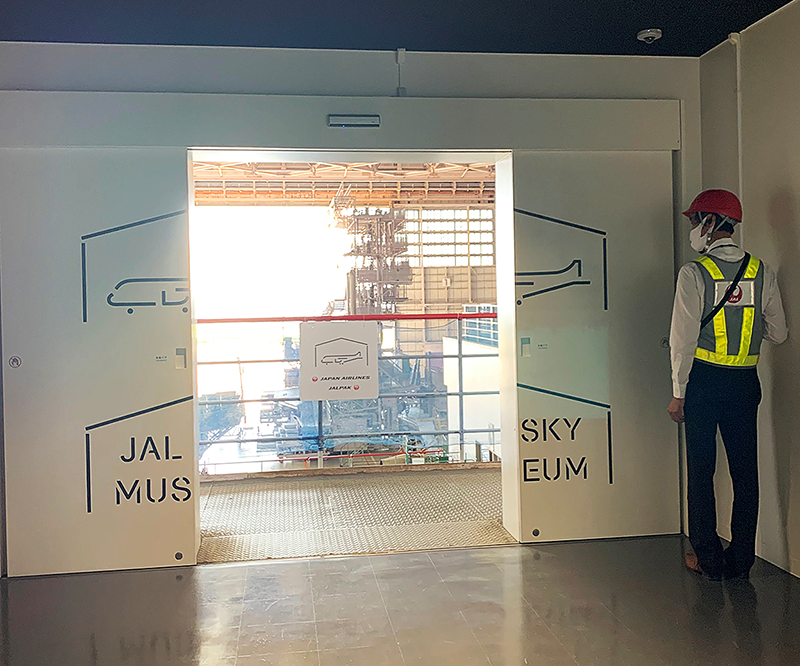 On to the hangar finally! The moment when the door opened was super exciting!
On to the hangar finally! The moment when the door opened was super exciting!
First up is Hangar 1. It really is huge! The size of the hangar is 40 m in height, 100 m in depth, and 175 m in width. This hangar is for performing regular inspections on airplanes, and it can store up to three planes.
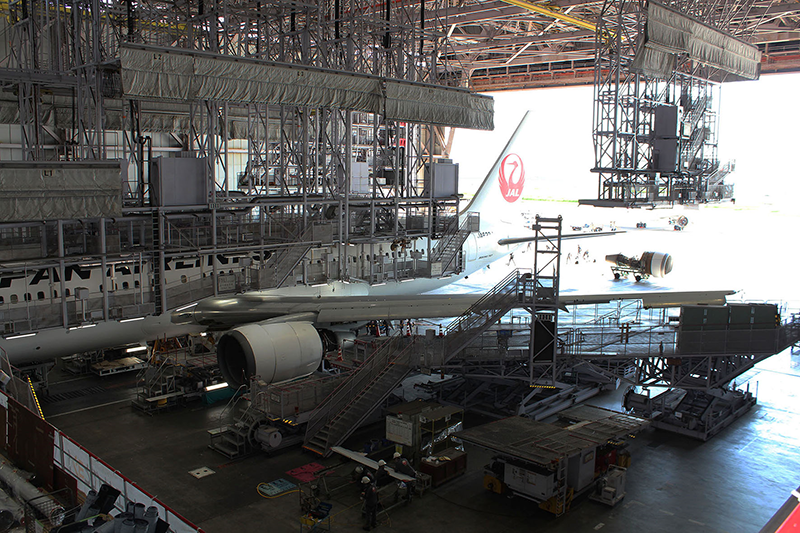 The size of Hangar 1 is about the same size as the ground area of Tokyo Dome.
The size of Hangar 1 is about the same size as the ground area of Tokyo Dome.
More trivia
The hangar was built using a special construction method called an underpinning method. There are no pillars in the hangar, yet it can withstand an earthquake with a seismic intensity of 7.
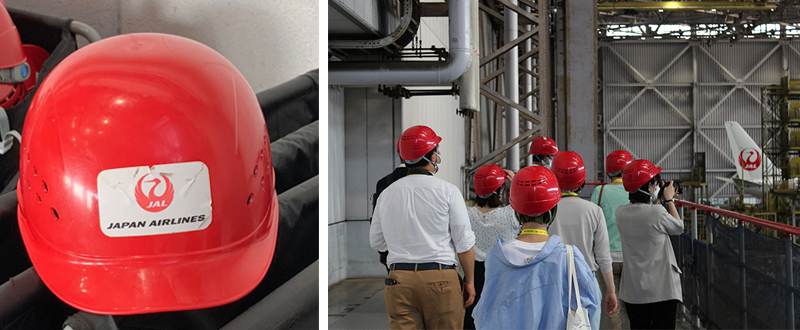 Since the visitors get very close to where all the maintenance engineers are working, you will be handed a red safety helmet.
Since the visitors get very close to where all the maintenance engineers are working, you will be handed a red safety helmet.
Through the connecting bridge, and on to Hangar 2. Hangar 2 has a width of about 200 m, which makes this hangar larger than Hangar 1. This hangar is mainly used for repairing planes and can store up to six of them. When we were there, weight and balance calculations (measuring weight) were being conducted. Even a little bit of wind can cause an error, so all the doors in the hangar were closed.
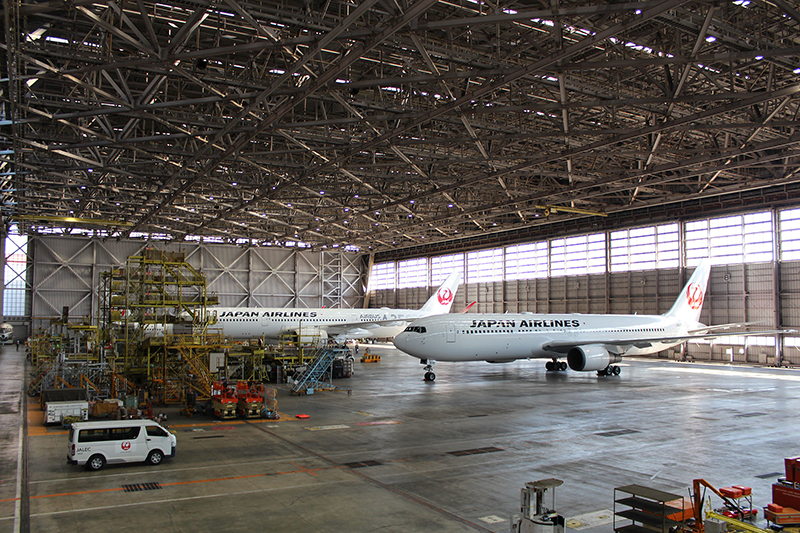 We were told that when the doors are open, we can see airplanes departing.
We were told that when the doors are open, we can see airplanes departing.
There were a Boeing 737, 767, and an Airbus A350 on this day with many maintenance engineers working their fingers to the bone. From seeing the workers move a huge screw by hoisting it with a crane and an engine taken out from a plane on the ground, we definitely could feel how enormous a plane is.
More trivia
When a crane is in operation within the hangar, a melody is played to prevent an accident. The melody played is different depending on the direction in which the crane is moving.
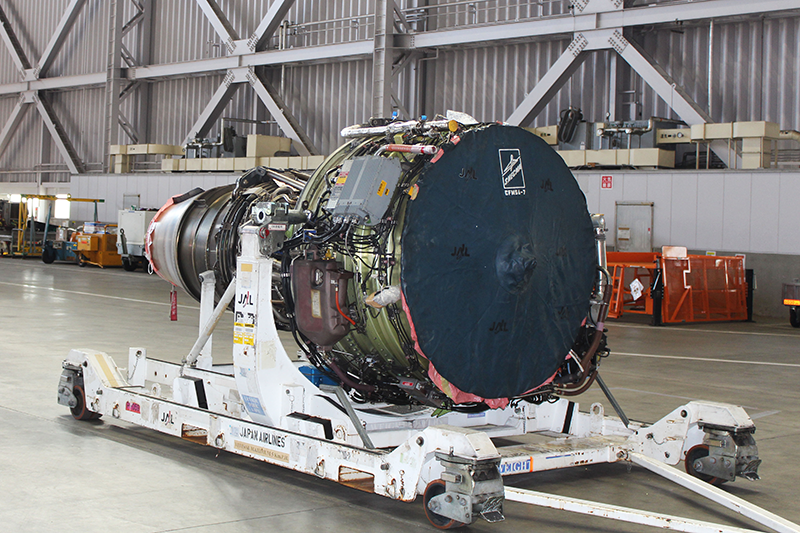 An engine taken out from a Boeing 737. When purchasing an airplane from Boeing, an engine can be chosen from three manufacturers (Rolls-Royce, General Electric, or Pratt & Whitney).
An engine taken out from a Boeing 737. When purchasing an airplane from Boeing, an engine can be chosen from three manufacturers (Rolls-Royce, General Electric, or Pratt & Whitney).
The nose of the first passenger jet in Japan, a Douglas DC-8 (FUJI) is stored in the corner of Hangar 2. It is a beautiful airplane also called a “lady of the sky.” It is famous because the Beatles came to Japan on this plane.
It was an era with no GPS, so a pilot had to judge where they were flying and how they would be flying from looking at the positions of the moon, the sun, and stars from the tiny window above.
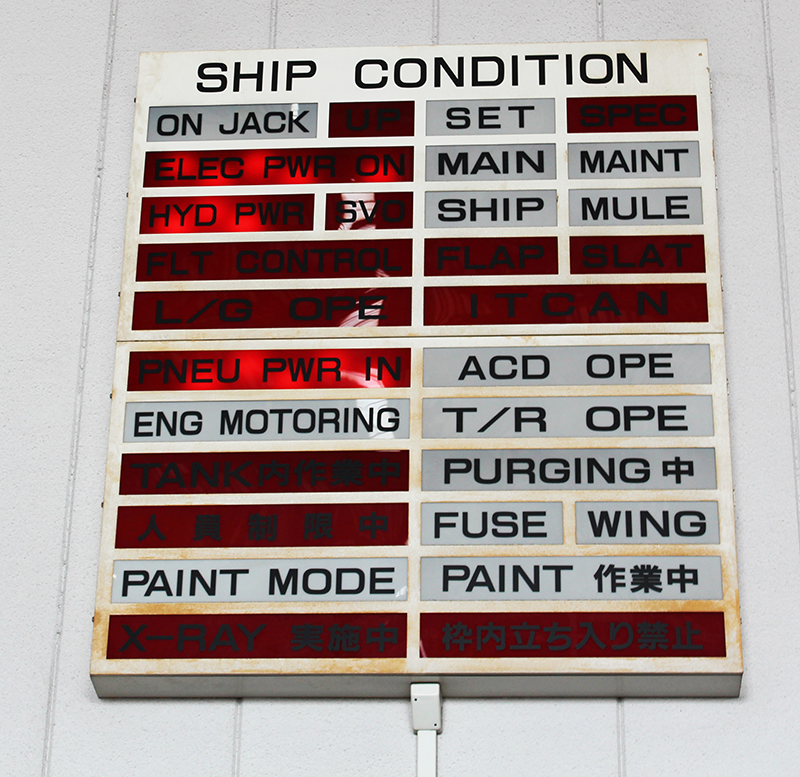
This is a bulletin board to show work processes. It is placed at a very high position on a wall of the hangar so that the workers can see it from afar. It is interesting to see that a plane is referred to as a ship rather than an airplane or aircraft.
More trivia
On an airplane, the left side is the main side for everything. A passenger entry door is on the left side of an aircraft, and so is the pilot’s seat. These rules related to operation are following their senior in transport and operations, ships.
Regular inspections in the hangar are performed at night when the planes are not in operation. Out of about 3,200 JAL maintenance engineers, roughly 1,400 work in Haneda. Lately, the number of female maintenance engineers is on the rise, with currently about 10% of them being female.
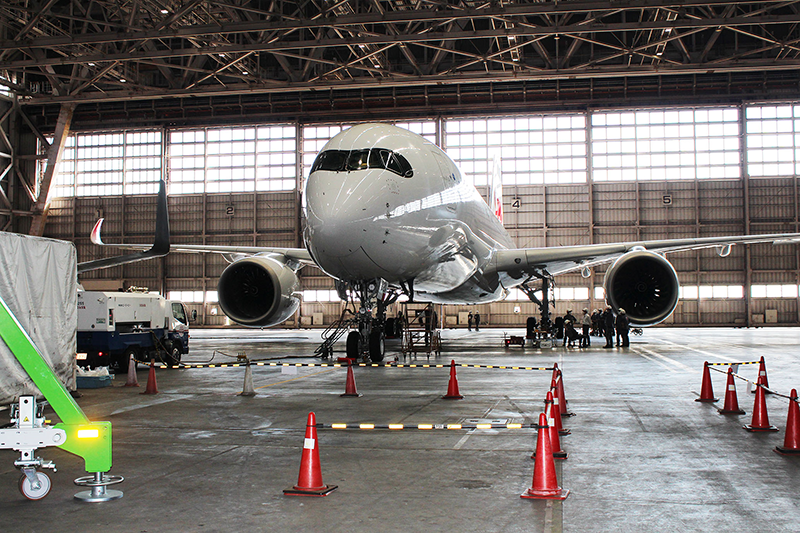 Many maintenance engineers were working on the inspection and repair. They are working day and night to protect the safety of passengers.
Many maintenance engineers were working on the inspection and repair. They are working day and night to protect the safety of passengers.
End of the tour: If only we had more time...
The 50-minute hangar viewing ended in a flash. We heard many episodes and stories about airplanes such as the FUJI that supported the initial era of JAL and how the numbers on the aircrafts are decided. It was definitely an enjoyable tour even without detailed knowledge about airplanes. Please come visit and give it a try.
Interview with JAL staff
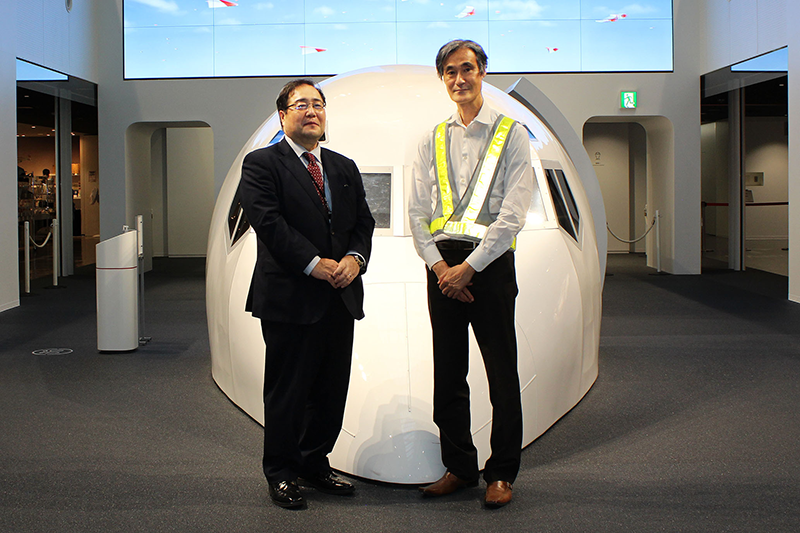 Right: Mr. Yasuhiko Watanabe , CSR Group Manager, ESG Promotion Department, General Affairs, Japan Airlines Co., Ltd.
Right: Mr. Yasuhiko Watanabe , CSR Group Manager, ESG Promotion Department, General Affairs, Japan Airlines Co., Ltd.
Left: Mr. Michihiro Hososhima , Deputy Manager, Research and Study Department, Policy Management Center, Japan Airlines Co., Ltd.
* People depicted in photos without masks were unmasked only when the photos were taken.
We had an interview with Mr. Yasuhiko Watanabe and Mr. Michihiro Hososhima of Japan Airlines Co., Ltd., who guided us through the tour.
- It finally reopened after the renovation.
Even after the renovation, we couldn’t open right away due to the pandemic, so it really is “finally.” In the past, we had about 10,000 visitors each month, four to five tours a day, 100 people per tour, totaling to about 120,000 visitors a year. As we’re still in the pandemic, we’re limiting the number of visitors and tours to two tours a day, 30 visitors per tour. The reservations open one month prior to the tour dates, but they get booked within about a minute. We are very sorry to those who have been waiting for this for a long time.
- What do you think is the point of interest after the renovation?
Digitalization for sure. As we increased the amount of digital content, it became easier for us to provide fulfilling information and change the content when we want to. I think the attractive point we now have here is that we have both analog displays visitors can watch and enjoy as well as digital displays which visitors touch and enjoy.
- What is the age range of visitors so far?
We have visitors of every age range. Some come as a family, with friends, or we sometimes have a group of elders. We also have field trips from elementary schools, vocational schools, and company training. It is indeed a facility people in any age range can enjoy.
- Who would you like to see as visitors in the future?
We would definitely like to see those who are interested in the industry, but also, because of the memories they have created here, we’d like visitors to choose JAL when they fly in the future. What makes us the happiest is to see many people enjoying the tour.
More trivia
JAL Factory Viewing Tour: JAL SKY MUSEUM is free to enjoy, but a JAL Factory Viewing Tour: JAL SKY MUSEUM FUJI Special package that comes with the viewing of the FUJI, the first passenger jet for JAL, was released as an option plan of a JAL pack (1,000 yen per person). This was a limited offer until the end of September 2022.
Check for details here →
https://www.jal.co.jp/jp/ja/domtour/jaldp/skymuseum/